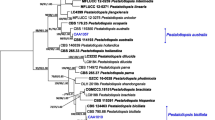Abstract
A new species of Neopestalotiopsis based on both morphological and molecular characteristics is described. Neopestalotiopsis iranensis sp. nov. isolated from rotted strawberry (Fragaria ananassa) fruits as well as from stolon and leaf lesions in Kurdistan province, Iran. Initially, light tan and sunken spots developed on fruits and resulted in a soft decay of the fruit flesh. The new species is morphologically distinguished from similar species with different conidium size and by possessing longer apical appendages, as well as some knobbed basal appendages. Phylogenetic analyses (Bayesian inference, maximum likelihood and maximum parsimony analyses) based on internal transcribed spacer, β-tubulin, and partial translation elongation factor 1-alpha combined gene sequences also indicated that this species is phylogenetically distinct from others. Moreover, strawberry crop is introduced here as a new host for N. mesopotamica.


Similar content being viewed by others
References
Arzanlou M, Torbati M, Khodaei S, Bakhshi M (2012) Contribution to the knowledge of Pestalotioid fungi of Iran. Mycosphere 3:871–878. doi:10.5943/mycosphere/3/5/12.871
Ayoubi N, Soleimani MJ (2013) Occurrence of Strawberry anthracnose disease caused by Colletotrichum acutatum in Kurdistan province. In: 1st Iranian Mycological Congress, 3–5 September, University of Guilan, Rasht, p 97
Bose S (1970) Diseases of valley fruits in Kumaon (III). Leaf-spot diseases of strawberry. Progress Hortic 2:33–35
Camili EC, Carbonari M, de Souza NL (2002) Characterization of Pestalotiopsis longisetula and its pathogenicity in strawberry. Summa Phytopathol 28(2):213–214
Das R, Chutia M, Das K, Jha D (2010) Factors affecting sporulation of Pestalotiopsis disseminata causing grey blight disease of Persea bombycina Kost., the primary food plant of muga silkworm. Crop Prot 29:963–968. doi:10.1016/j.cropro.2010.05.012
Doyle JJ, Doyle JL (1987) A rapid DNA isolation procedure for small quantities of fresh leaf tissue. Phytochem Bull 19:11–15
Embaby E (2007) Pestalotia fruit rot on strawberry plants in Egypt. Egypt J Phytopathol 35:99–110
Guba EF (1961) Monograph of monochaeta and pestalotia. Harvard University Press, Cambridge
Howard C, Albregts E (1973) Strawberry fruit rot caused by Pestalotia longisetula. Phytopathology 63:862–863
Hu H, Jeewon R, Zhou D, Zhou T, Hyde KD (2007) Phylogenetic diversity of endophytic Pestalotiopsis species in Pinus armandii and Ribes spp.: evidence from rDNA and β-tubulin gene phylogenies. Fungal Divers 24:1–22
Huelsenbeck JP, Ronquist F (2001) MRBAYES: Bayesian inference of phylogenetic trees. Bioinformatics 17:754–755
Keith LM, Velasquez ME, Zee FT (2006) Identification and characterization of Pestalotiopsis spp. causing scab disease of guava, Psidium guajava, in Hawaii. Plant Dis 90:16–23
Ling X, Kusakari S, Hosomi A, Toyoda H, Ouchi S (1999) Postharvest disease of grape caused by Pestalotiopsis species. Ann Phytopathol Soc Jpn 65:305–311
Maharachchikumbura SS, Chukeatirote E, Guo L-D, Crous PW, Mckenzie EH, Hyde KD (2013) Pestalotiopsis species associated with Camellia sinensis (tea). Mycotaxon 123:47–61
Maharachchikumbura SS, Guo LD, Cai L, Chukeatirote E, Wu WP, Sun X, Crous PW, Bhat DJ, McKenzie EH, Bahkali AH, Hyde KD (2012) A multi-locus backbone tree for Pestalotiopsis, with a polyphasic characterization of 14 new species. Fungal Divers 56:95–129. doi:10.1007/s13225-012-0198-1
Maharachchikumbura SS, Guo LD, Chukeatirote E, Bahkali AH, Hyde KD (2011) Pestalotiopsis—morphology, phylogeny, biochemistry and diversity. Fungal Divers 50:167–187
Maharachchikumbura SS, Guo LD, Chukeatirote E, Mckenzie EH, Hyde KD (2013) A destructive new disease of Syzygium samarangense in Thailand caused by the new species Pestalotiopsis samarangensis. Tropical Plant Pathol 38:227–235. doi:10.1590/S1982-56762013005000002
Maharachchikumbura SS, Hyde KD, Groenewald JZ, Xu J, Crous PW (2014) Pestalotiopsis revisited. Stud Mycol 79:121–186
Nylander JAA (2004) MrModeltest v2. Program distributed by the author. Evolutionary Biology Centre, Uppsala University, Uppsala
Page RDM (1996) TREEVIEW: an application to display phylogenetic trees on personal computers. Comput Appl Biosci 12:357–358
Royse D, Ries S (1976) A cortical decay of petioles and stolons of strawberry caused by Pestalotia longisetula (Fungal diseases). Plant Dis Rep 60:901–902
Ronquist FM, Teslenko M, van der Mark P, Ayres DL, Darling A, Höhna S, Larget B, Liu L, Suchard MA, Huelsenbeck JP (2012) MrBayes 3.2: efficient Bayesian phylogenetic inference and model choice across a large model space. Syst Biol 61:539–542. doi:10.1093/sysbio/sys029
Shitole D, Patil U, Pawar N (2000) In vitro evaluation of chemicals and antibiotics against important fruit rotting fungi of strawberry. J Maharashtra Agric Univ 25:179–181
Song Y, Geng K, Zhang B, Hyde KD, Zhao WS, Wei JG, Kang JC, Wang Y (2013) Two new species of Pestalotiopsis from Southern China. Phytotaxa 126(1):22–30
Sutton BC (1980) The Coelomycetes. Fungi imperfecti with pycnidia, acervuli and stromata. Commonwealth Mycological Institute, Kew
Swofford DL (2003) {PAUP*. Phylogenetic analysis using parsimony (* and other methods). Version 4.}
Stamatakis A, Ludwig T, Meier H (2005) RAxML-III: a fast program for maximum likelihood-based inference of large phylogenetic trees. Bioinformatics 21:456–463
Thompson JD, Gibson TJ, Plewniak F, Jeanmougin F, Higgins DG (1997) The CLUSTAL_X windows interface: flexible strategies for multiple sequence alignment aided by quality analysis tools. Nucl Acids Res 25:4876–4882
Wei JG, Xu T (2004) Pestalotiopsis kunmingensis sp. nov., an endophyte from Podocarpus macrophyllus. Fungal Divers 15:247–254
Yasuda F, Kobayashi T, Watanabe H, Izawa H (2003) Addition of Pestalotiopsis spp. to leaf spot pathogens of Japanese persimmon. J Gen Plant Pathol 69:29–32
Zhang Y, Maharachchikumbura SS, Mckenzie EH, Hyde KD (2012) A novel species of Pestalotiopsis causing leaf spots of Trachycarpus fortunei. Cryptogam Mycol 33:311–318. doi:10.7872/crym.v33.iss3.2012.311
Acknowledgments
Partial financial support for this work by a research grant (No. 32-996) from the Research Council of Bu-Ali Sina University, Hamedan, Iran, is gratefully acknowledged. We also wish to thank Dr. D. Zafari, Dept. Plant Protection, Bu-Ali Sina University, for facilitating the molecular work.
Author information
Authors and Affiliations
Corresponding author
Rights and permissions
About this article
Cite this article
Ayoubi, N., Soleimani, M.J. Strawberry Fruit Rot Caused by Neopestalotiopsis iranensis sp. nov., and N. mesopotamica . Curr Microbiol 72, 329–336 (2016). https://doi.org/10.1007/s00284-015-0955-y
Received:
Accepted:
Published:
Issue Date:
DOI: https://doi.org/10.1007/s00284-015-0955-y




